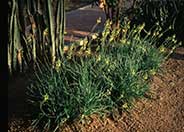
Common name:Yellow Stalked Bulbine
Botanical name:Bulbine frutescens
Bulbine frutescens is an evergreen perennial that grows 1.5' tall and wide. The leaves are narrow and long. This low-spreading plant is attractive year round.
Maintenance Tips
Bulbine frutescens is a grass-like succulent that has a very dense form that can grow 18" tall and wide. It can bloom throughout the year and is very attractive to hummingbirds, bees, and butterflies. To keep this plant low maintenance, plant it in full sun with excellent drainage. Rock gardens are a perfect location. The plant is drought tolerant once established but will require some supplemental soil as it is rooting. This plant can spread from underground roots, so it can be invasive if it is happy in the environment. There is very little maintenance required to keep it looking and performing its best, but it should be divided every couple of years to invigorate it. If the plant looks dull and discolored, there is a good chance it is going into its drought mode, so some supplemental water will kick start it again.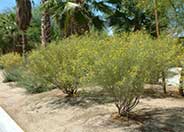
Common name:Feathery Cassia or Senna
Botanical name:Senna artemisioides
This evergreen shrub grows to 4'-6' tall and wide. It has leaves that are narrowly pinnate, forming feathery sprays of silvery foliage. Its showy yellow flowers appear at branch tips from late winter through early summer. A very tough plant, this variety will survive under desert conditions or near the coast. It will even tolerate clay soils if kept dry during the summer. The plant is damaged below 20 degrees F.
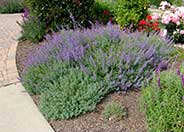
Common name:Catmint
Botanical name:Nepeta X faassenii
Nepeta faassenii makes soft, gray green, undulating mounds that are 1.5' high when blooming. The small leaves are attractive to cats. This perennial has lavender blue flowers in late spring and early summer.
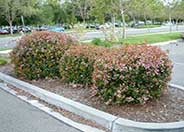
Common name:Glossy Abelia
Botanical name:Abelia X grandiflora
Abelia X grandiflora is a semi-evergreen shrub of medium size. It has small, white, fragrant flowers that bloom from spring through the fall season. Bracts add a bronzy tint to the flowers. Abelia makes a good sheared hedge or screen. When unsheared, it is naturally arching.
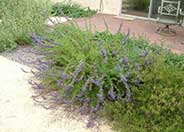
Common name:Woolly Blue Curls
Botanical name:Trichostema lanatum
The Woolly Blue Curls is an evergreen shrub that reaches 3'-5' high. It has an open branching habit and has long stalks of brilliant purple woolly flowers in the spring and summer. This shrub is native to California, is drought tolerant, and attracts hummingbirds.
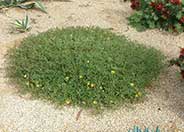
Common name:Sundrops
Botanical name:Calylophus hartwegii
This low-growing perennial grows 1' tall and 3' tall; it has woody stems with bright green leaves. It produces large, lemon yellow flowers that are up to 4" across and bloom spring through summer and possibly through fall, depending on weather conditions.
Maintenance Tips
Calylophus hartwegii is a soft-textured, low-growing perennial with bright yellow flowers. It only grows 12" tall and up to 3' wide. It is very fast growing in the late winter and early spring, and then it is covered with flowers from mid-spring until fall if the weather is ideal. In the fall, when the days start to get shorter and the rains begin, this plant can decline. The root system will stay intact, but the flowering stops, and the foliage will completely die back. This plant benefits from hard pruning, taking the foliage, and branching almost down to the ground. Don't expect any new growth to emerge until the days start to get longer and warm up. The foliage will start to emerge, and the plant's quick growth and blooming cycle will return.Designer: Susan Triindle
Photographer: GardenSoft
Practice grass-cycling by leaving short grass clippings on lawns after mowing, so that nutrients and organic matter are returned to the soil.
Drip and other smart irrigation delivers water directly to roots, allowing no excess water for weeds.